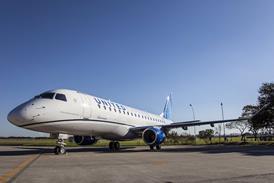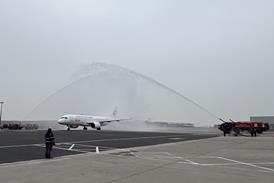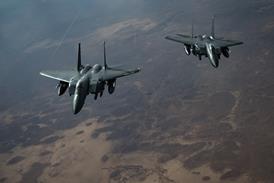When this decade is analysed by aviation historians, it will surely be singled out as the second most innovative period in the history of rotorcraft (see Feature P88). After half a century of conservatism - following some revolutionary rotorcraft designs introduced in the early 1950s - the technology has finally caught up with the design brief. And this same technology is helping industry once more to think out of the box.
 |
|---|
| Eurocopter Eurocopter's X3 demonstrator is touring the USA |
Three new rotorcraft are poised to enter the market and, for once, they cannot be dismissed as mere variations on a theme. The ground-breaking civil tiltrotor, first flown back in 2003, has two new takes on the compound technology theme to compete with.
Before 2020, the manufacturers will be marketing their solutions. Will there be places for all of them in an ever-expanding rotorcraft marketplace? Or will a cautious end-user ensure they end up portrayed as an interesting footnote in Wikipedia?
Almost since its first flight in 1989, the development of the military Bell-Boeing V-22 was dogged by funding fights and its introduction to service marred by fatal accidents. Even today, pressure groups continue to attack the Osprey's maintenance and safety records, together with the sheer cost of the package.
Its civil BA609 counterpart was relegated to the status of runt of the litter. Distracted by its V-22 tribulations, Bell Helicopter transferred more responsibility for the project to its Italian partner. Finally, in 2011, AgustaWestland took on the whole programme, ring-fenced a budget and committed to seeking FAA certification for the (now) AW609 during 2016.
FORWARD SPEED
The tiltrotor's flight-test programme is the most advanced of the technologies. The two original prototypes, now to be joined by a further two aircraft, have flown more than 650 flight hours - more than the competition, but not a lot to show for nine years of effort.
The team has validated much of the flight envelope, including a ceiling of 25,000ft (7,620m) and speeds of 275kt, all at maximum weight. To date, 85% of the test programme has been completed.
The AW609 has the edge in forward speed. Although technically the most complicated of the three designs, conservative helicopter operators will be more familiar with its merits.
The nine-passenger payload will fit a very specific offshore profile and its relatively large footprint will be of concern to emergency medical service (EMS) or search and rescue operators (SAR). One German director said that the AW609 would be unlikely to squeeze into the vast majority of its landing sites.
While the size of its cabin would have to be addressed, the tiltrotor principle seems more likely to find a niche in the public transport and corporate roles, where it can speed along airways and land at airports without the need for a precious landing slot and where the noise of its hovering can be dissipated. A fleet of tiltrotors could link London airports with regional hubs such as Birmingham and Southampton, freeing up slots for international flights. That is, of course, if the proponents of the various options for relieving this congestion are made aware of its potential.
The OEM says it has an order book of some 70 aircraft for 40 customers. The price has not yet been revealed: AgustaWestland wants to leave that announcement until two years before the start of series production. Managing director Robert LaBelle says the company expects a production run of 450 to 500 aircraft.
The 609's price will be more of an issue, now that its commercial advantage has been squandered. In 2008, Sikorsky announced and flew its sleek X2 compound demonstrator, a variation on its Advancing Blade Concept (ABC). Over three years, the craft achieved a forward speed of 253kt (a rotor-mast fairing could add a further 10-15kt) before progress was abruptly halted.
The X2, it was announced, would be transformed into the S-97 Raider, a contender for a US Army competition. However, programme director Doug Shidler says that the team will "continue to evaluate possible commercial applications".


The aircraft last flew in July 2011. Shidler explains: "We announced the S-97 Raider as a contender for the US Army's armed aerial scout programme, which expresses the need to bring in a replacement for the Bell Kiowa Warrior OH-58D.
"An RFI [request for information] has since been issued with a deadline for industry to respond by the end of the year. Soon after that, the choice will be made between issuing a service life extension to the Kiowa and launching a competition for a replacement." Sikorsky is banking on the latter option, opening the way to flight trials in the 2014-15 timeframe. However, severe restrictions on R&D funding from the military may work against the OEM.
Chief engineer Bill Eadie says the Raider will have "a smaller diameter rotor and 15% reduced footprint over the 58D. Its sustained cruise speed will be double that of the 58D and it will be able to hover in a 95o [F] day at 10,000ft." The cost of acquiring and owning these benefits has yet to be revealed.
SMALLER DOWNWASH
The Raider cockpit will take two pilots in a new side-by-side configuration and up to six combat-equipped troops. The type is being pitched to Pentagon officials, but its commercial potential has yet to be explored in detail. Says Shidler: "We have no active programmes in place. However, we do believe there are opportunities for commercial variants, where you might want to reduce exposure time over the sea, say, or response time to an emergency call. It has a much smaller downwash than a regular helicopter, it's more stable, and it is extremely scalable."
Of the three new concepts, ABC will require a greatest leap of faith from the commercial customer. Sikorsky clearly sees its combination of outright speed and hot-and-high performance as a much easier "sell" to the military community. Eurocopter did not enter the fray until September 2010, when it announced the imminent first flight of its X3 ("X-cubed") hybrid, a technology "mash-up" of fuselage from one helicopter, main rotor from another and engines from a third, with stub wings and tractor propellers designed to achieve similar forward speeds to the X2.
 |
|---|
| Sikorsky Sikorsky's X2 has reached a forward speed of 253kt |
HIGH CONCEPT
The proof-of-concept demonstrator will be developed into the H3 programme to meet the expected demand for high-speed helicopters. Eurocopter executive vice-president Jean-Michel Billig believes, however, that this should not be achieved "at any cost". However €143 million ($187 million) of state R&D funding, approved in March 2012 by the European Commission, will surely make life easier.
The X3 demonstrator is on a six-week tour of the USA before it heads to the ILA air show in Berlin in September. It started from Eurocopter USA's Texas headquarters and is working its way via five (mainly US Department of Defense) stopovers to Washington DC, where it will be introduced to Congress and the Pentagon. The company says it is pursuing most of the applications available to conventional helicopters: however, as a concept rather than a mission demonstrator.
Executive vice-president of research Jean-Brice Dumont told Flight International that it is not yet targeting any particular customer groups: "Our aim is to demonstrate the simplicity of the X3 concept, and to show pilots that in terms of handling it retains all the features of the helicopter.
"We are very satisfied with the level of performance achieved during the (spring 2012) flight test programme, especially regarding systems such as the thruster blades and FADEC [full-authority digital engine control], which were required to operate outside their original flight envelope."
These two permanently vertical thrusters on the X3 stub-wings will need careful aircrew management, especially during ground operations at unfamiliar sites. This may limit its appeal in some reactive roles, EMS or SAR for example.
However, it provides the most serious competition to the tiltrotor and will hold the technology advantage. Sikorsky and Eurocopter are keen to stress the "scalability" of their designs - but that term has so far been avoided by AgustaWestland.
A civil variant of the Quad Tilt Rotor, or even the V-22 Osprey, might fit the payload bill but would require a Herculean effort to convince the other interested parties.
PIASECKI ADAPTS DESIGN FOR FASTER FLIGHT
Like Eurocopter, the pioneering rotorcraft firm Piasecki has been investigating winged compounds. In 2007, the company flew its X-49, a Seahawk adapted to carry a wing and, to offload the rotor in forward flight, an eight feet-diameter Vectored Thrust Ducted Propeller. It is currently studying a 270-knot VDTP compound, under the US government's Joint Multi-Role technology initiative to develop a family of new-technology rotorcraft.
 |
|---|
| Piasecki The Piasecki X-49 version of the Seahawk carries a wing and VTDP |
VTDP technology provides anti-torque and yaw control plus forward thrust. In combination with a lifting wing, this technology unloads the rotor, allowing the helicopter to fly faster and further. It is said to be more manoeuvrable and offers reduced vibration and fatigue loads, improving reliability and lowering life-cycle costs.
The wing unloads the rotor as speed increases, allowing the latter to slow and reduce drag. Vibration and fatigue loads are reduced "at source", eliminating the need for active vibration control. It also provides a redundant means of lift and control and can even be used to stow fuel, enabling the long ranges.
Funding, however, will be key to the X-49's progress. Severe restrictions on rotorcraft R&D restrict the military's room for manoeuvre, and Congress is being asked to slash even basic research in its calculations for FY2013.
Source: Flight International























